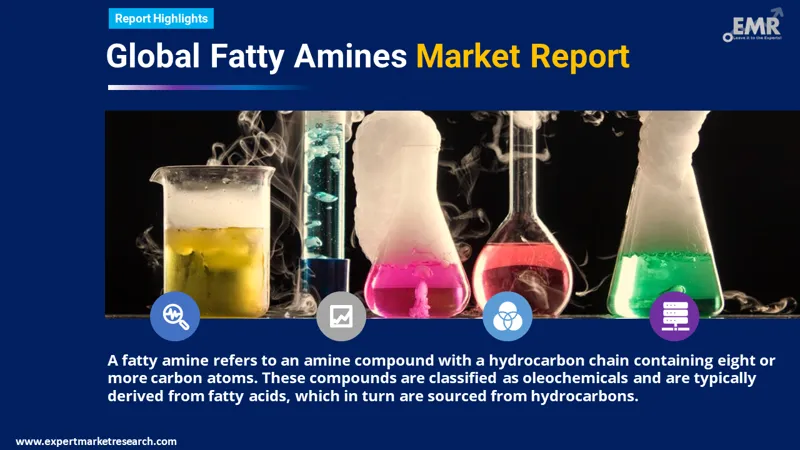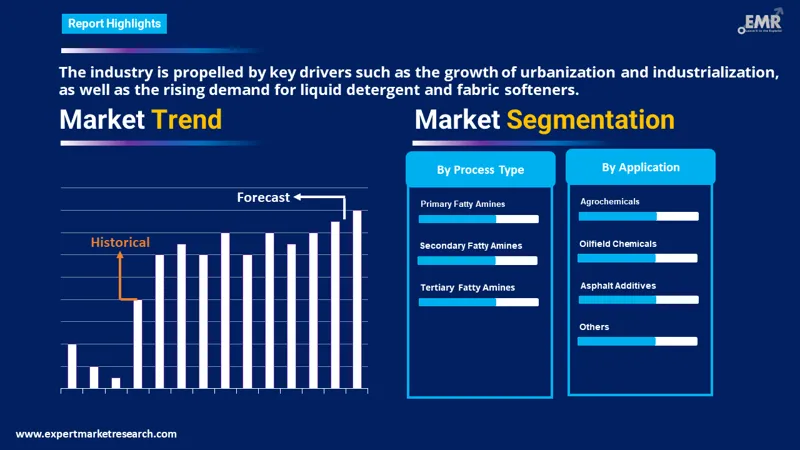
Consumer Insights
Uncover trends and behaviors shaping consumer choices today
Procurement Insights
Optimize your sourcing strategy with key market data
Industry Stats
Stay ahead with the latest trends and market analysis.
The global fatty amines market size reached a value of USD 4.68 Billion in 2025. The fatty amines market is further anticipated to grow over the forecast period of 2026-2035 at a CAGR of 5.30%, reaching a value of USD 7.84 Billion by 2035.
Base Year
Historical Period
Forecast Period
Compound Annual Growth Rate
5.3%
Value in USD Billion
2026-2035
*this image is indicative*
Derivatives and products of fatty amines are used to produce cleaning, emulsifying, scouring, and wetting agents for various products, including personal care, home care, and lubricants, thus, accelerating the demand for fatty amines.

Read more about this report - REQUEST FREE SAMPLE COPY IN PDF
A fatty amine is an amine that has eight or more carbon atoms in length connected to a hydrocarbon chain. These are categorized as oleochemical compounds. Fatty amines are more commonly derived from hydrocarbons C12-C18, which in turn are derived from the more abundant fatty acids. The fatty amines market can be segmented into product type and application.
Based on product type, the industry can be divided as:
The industry can be broadly categorised based on its application segments into:
Looks into the regional fatty amines markets like:

Read more about this report - REQUEST FREE SAMPLE COPY IN PDF
The increasing demand for liquid detergent and fabric softeners is anticipated to accelerate the fatty amines market growth in developed economies. In addition, the low cost of raw materials and their ample availability, coupled with low levels of toxicity and low cost of production, are the dynamics that are predicted over the forecast period to open lucrative growth opportunities for the fatty amines market.
The primary fatty amines are projected to witness the most rapid growth due to their quality of being used as a fundamental raw material for the production of secondary and tertiary amines, which is expected to fuel the development of this product type in the coming years. Tertiary amines are used as floatation for ores, fuel additives, chemical intermediates, and inhibitors of corrosion, which are accelerating the demand for tertiary fatty amines.
The report presents a detailed analysis of the following key players in the global fatty amines market, looking into their capacity, competitive landscape, and latest developments like capacity expansions, plant turnarounds, and mergers and acquisitions:
The EMR report gives an in-depth insight into the industry by providing a SWOT analysis as well as an analysis of Porter’s five forces.




*While we strive to always give you current and accurate information, the numbers depicted on the website are indicative and may differ from the actual numbers in the main report. At Expert Market Research, we aim to bring you the latest insights and trends in the market. Using our analyses and forecasts, stakeholders can understand the market dynamics, navigate challenges, and capitalize on opportunities to make data-driven strategic decisions.*
Get in touch with us for a customized solution tailored to your unique requirements and save upto 35%!
The global fatty amines market attained a value of nearly USD 4.68 Billion in 2025.
The market is projected to grow at a CAGR of 5.30% between 2026 and 2035.
Major industry drivers include rising urbanisation, rising industrialisation, and the increasing demand for liquid detergent and fabric softeners.
Due to their quality of being used as a fundamental raw material to produce secondary and tertiary amines and the low cost of raw materials and their ample availability are few of the key trends pushing this industry.
The major regions in the industry are North America, Latin America, the Middle East and Africa, Europe, and the Asia Pacific.
The significant types of fatty amines are primary fatty amines, secondary fatty amines, and tertiary fatty amines.
Agrochemicals, oilfield chemicals, asphalt additives, anti-caking, water treatment, chemical synthesis, personal care, and household, among others are the leading application segments of fatty amines.
The major players in the industry are Kao Corporation, Ecogreen Oleochemicals (Singapore) Pte Ltd, Evonik Industries AG, Volant-Chem Corp., Solvay S.A, Global Amines Company Pte. Ltd., Nouryon Chemicals Holding B.V., AkzoNobel N.V., KLK OLEO, Others.
Explore our key highlights of the report and gain a concise overview of key findings, trends, and actionable insights that will empower your strategic decisions.
| REPORT FEATURES | DETAILS |
| Base Year | 2025 |
| Historical Period | 2019-2025 |
| Forecast Period | 2026-2035 |
| Scope of the Report |
Historical and Forecast Trends, Industry Drivers and Constraints, Historical and Forecast Market Analysis by Segment:
|
| Breakup by Product Type |
|
| Breakup by Application |
|
| Breakup by Region |
|
| Market Dynamics |
|
| Competitive Landscape |
|
| Companies Covered |
|
| Report Price and Purchase Option | Explore our purchase options that are best suited to your resources and industry needs. |
| Delivery Format | Delivered as an attached PDF and Excel through email, with an option of receiving an editable PPT, according to the purchase option. |
Datasheet
One User
USD 2,499
USD 2,249
tax inclusive*
Single User License
One User
USD 3,999
USD 3,599
tax inclusive*
Five User License
Five User
USD 4,999
USD 4,249
tax inclusive*
Corporate License
Unlimited Users
USD 5,999
USD 5,099
tax inclusive*
*Please note that the prices mentioned below are starting prices for each bundle type. Kindly contact our team for further details.*
Flash Bundle
Small Business Bundle
Growth Bundle
Enterprise Bundle
*Please note that the prices mentioned below are starting prices for each bundle type. Kindly contact our team for further details.*
Flash Bundle
Number of Reports: 3
20%
tax inclusive*
Small Business Bundle
Number of Reports: 5
25%
tax inclusive*
Growth Bundle
Number of Reports: 8
30%
tax inclusive*
Enterprise Bundle
Number of Reports: 10
35%
tax inclusive*
How To Order

Select License Type
Choose the right license for your needs and access rights.

Click on ‘Buy Now’
Add the report to your cart with one click and proceed to register.

Select Mode of Payment
Choose a payment option for a secure checkout. You will be redirected accordingly.
Gain insights to stay ahead and seize opportunities.

Get insights & trends for a competitive edge.

Track prices with detailed trend reports.

Analyse trade data for supply chain insights.

Leverage cost reports for smart savings

Enhance supply chain with partnerships.

Connect For More Information
Our expert team of analysts will offer full support and resolve any queries regarding the report, before and after the purchase.
Our expert team of analysts will offer full support and resolve any queries regarding the report, before and after the purchase.
We employ meticulous research methods, blending advanced analytics and expert insights to deliver accurate, actionable industry intelligence, staying ahead of competitors.
Our skilled analysts offer unparalleled competitive advantage with detailed insights on current and emerging markets, ensuring your strategic edge.
We offer an in-depth yet simplified presentation of industry insights and analysis to meet your specific requirements effectively.
Share